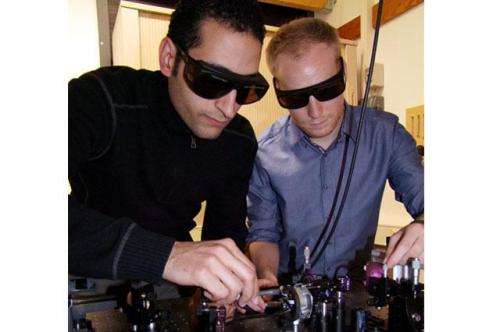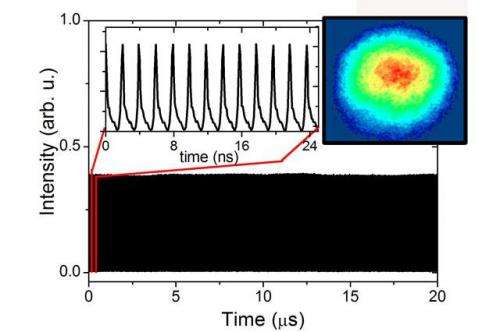First demonstration of harmonic mode-locking in a self-mode-locked VECSEL

Research in Germany has produced the first demonstration of harmonic mode-locking in a self-mode-locked VECSEL. Such devices have the potential to provide pulsed sources across the achievable spectral range of VECSELs, without the complexities and costs of saturable absorbers.
Laser Lock
VECSELs are a versatile laser type that can be readily tailored to the wavelength needs of specific applications. Continuous wave (CW) operation of VECSELs has been shown from 620 nm to 5 µm and, by exploiting intra-cavity second harmonic generation, their range can reach 338 nm.
Through the use of mode-locking, VECSELs can also be used for applications needing pulsed radiation sources; including frequency combs and ultra-fast spectroscopy, as well as biological and medical applications like multi-photon microscopy. In short, the VECSEL is potentially a cheap and reliable replacement for many bulky and expensive state-of-the art lasers.
To achieve mode-locking, VECSELs normally incorporate a saturable absorber in the laser cavity, most frequently in the form of a semiconductor saturable absorber mirror (SESAM). The use of SESAMs is well understood in VECSELS and once a suitable SESAM has been developed for a desired laser a good pulsed unit can be reliably produced. But the use of SESAMs brings costs.
Unnecessary limits?
SESAMs have to be carefully developed for each spectral range and their production is costly and time consuming. In operation they have other kinds of cost as the SESAM's device parameters, such as saturation fluence, modulation depth and the carrier lifetime, set limits on the laser's output power and pulse duration. In the last few years, however, it was discovered that mode-locking in a VECSEL can be achieved without using a SESAM, this is known as self mode-locking (SML).

The precise mechanism that allows SML is not well understood as Mahmoud Gaafar, one of the members of the German team, explained: "No obvious physical mechanism was known that would let one expect mode-locking without a SESAM is possible. Thus, no driving force existed to place a slit in the VECSEL's cavity, which is needed to achieve SML and which discloses an analogy to Kerr-lens mode-locking. Probably, the phenomenon was discovered by coincidence as it happened when Kerr-lens mode-locking in Ti-Sapphire lasers was discovered. Still, the SML mechanism has not been understood yet, because a giant nonlinear refractive index has to be assumed within the gain region to explain a sufficient Kerr-lensing effect."
Building harmonies
Despite the questions over the exact mechanism that allows it, several groups have reported VECSELs displaying SML, but in their Letter the team from Phillips-Universität, Marburg and NAsP III/V GmbH also report mode-locking of the second and third harmonic of their VECSEL's fundamental frequency.
With harmonic mode-locking, high repetition rates can be achieved whilst still using a practical cavity length of a few centimetres. Lasers with high repetition are required in many fields, including optical telecommunication and ultrafast optical spectroscopy, and to date lasers using SESAMs have been seen as the answer. It is in this context that the Marburg team's work demonstrates the possibility of achieving high repetition rates without a SESAM limiting the VECSEL's performance.
The team believe that this work can lead to compact, cost-efficient self-mode-locked lasers that can be used in a wide range of applications. They are now working to improve the performance of their SML VECSELs, to shorten the pulse-width and increase output power, with the aim of providing a real, efficient, lower-cost alternative to commercial mode-locked lasers.
New horizons
As well as their mode-locking work the Marburg team are interested in many other aspects of VECSEL development, including high power (>100W) CW operation and beam quality. Recent developments in mode-locked VECSELs have seen output powers rise to new peaks, but, in many cases, the output power is not limited by the heating inside the VECSEL-chip itself but heating of the SESAM. "With SML the lossy saturable absorber can be eliminated and the output powers of these systems further increased," said Gaafar.
However, the team note that the as-yet unresolved question of the underlying mechanism of SML is likely to be key to exploiting the full potential of SML VECSELs. A proper understanding could, they believe, allow further improvement of SML VECSELs to create devices with output powers in the tens of watts and pulse durations of a few hundred fs within the next decade.
More information: "Harmonic self-mode-locking of optically pumped semiconductor disc laser." M. Gaafar, et al. Electronics Letters, Volume 50, Issue 7, 27 March 2014, p. 542 – 543. DOI: 10.1049/el.2014.0157
Journal information: Electronics Letters
Provided by Institution of Engineering and Technology
This story is published courtesy of Electronics Letters. For additional Electronics Letters news and features visit theiet.org/eletters



















